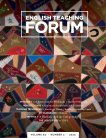
“On the Cover”: The cover shows an image of Crazy Quilt from the Smithsonian American Art Museum. Quilts are functional because they protect people from the cold, but the quilts often express creativity and preserve cultural traditions. Quilting bees—in which quilters work together on one or more quilts—and other gatherings have long strengthened feelings of community and serve as a way for quilters to share and pass along their craft. Crazy Quilt, with 20 unique squares containing similar colors and recurring shapes and images, dates to the early 20th century.
International Subscriptions: English Teaching Forum is distributed through U.S. Embassies. If you would like to subscribe to the print version of English Teaching Forum, please contact the Public Affairs or Cultural Affairs section of the U.S. Embassy in your country.
U.S. Subscriptions: English Teaching Forum is exempted from the Congressional restriction on distribution of Department of State-produced materials in the United States. U.S. residents who want to order the printed edition can order from the U.S. Superintendent of Documents.
Author Jimalee Sowell explains the branches of the Community of Inquiry framework and shows how they can be applied to ELT workshops. Numerous examples are given, along with a sample workshop design that is based on collaborative writing but can serve as a model for workshops on other topics.
Format: Text
Creating podcasts gives students opportunities to practice English in meaningful ways, be creative, and develop skills that can be put to use inside and outside the classroom. Author Enock Mbenza offers specific examples and provides organizational templates that students can apply to almost any topic.
Format: Text
This guide is designed to enrich your reading of the articles in this issue. You may choose to read them on your own, taking notes or jotting down answers to the discussion questions below. Or you may use the guide to explore the articles with colleagues.
Laura Loder Buechel explores the many ways that scavenger hunts can add fun, movement, collaboration, and practical applications of knowledge to English language learning. The article includes detailed descriptions of different kinds of hunts, many of which are appropriate for young learners, and includes templates and ready-to-use ideas.
Format: Text
Author Vanesa Polastri loves to give her learners stories (and other texts) that contain “gaps of indeterminacy”—that is, missing information that the learners must provide by using hints in the texts, their own knowledge, and their imagination. The author suggests ways the technique can be used for learners of different ages and language levels.
Format: Text
Learn how Claudia Andrade Serrano engaged her students with a place-based language-learning project that involved planting churqui-tree “seed bombs.” Students used English throughout the project, from making and planting the seed bombs to writing and sharing original poems about nature. The article, written by Susan Huss-Lederman, conveys the students’ enthusiasm and includes thoughts on how other teachers can try similar projects of their own.
Aaron Mermelstein offers a ready-to-use way to give students a chance to make decisions about projects that could improve their college campus. The challenge is that the budget cannot cover every project, so students must decide which projects to fund—and they must be ready to defend their decisions.
Format: Text
Can you complete the given sentences and create i-d-e-a sentences in this puzzle, which is based on the word idea?